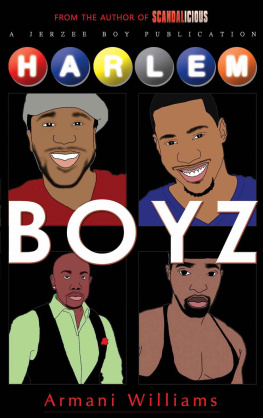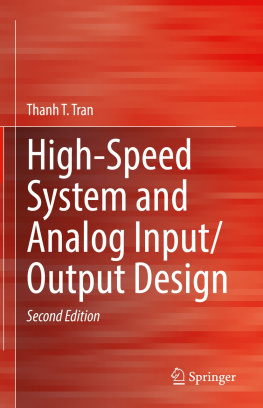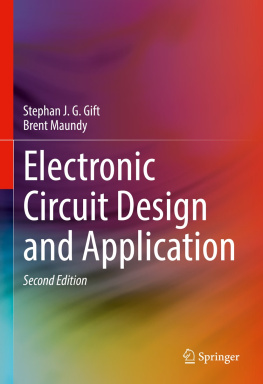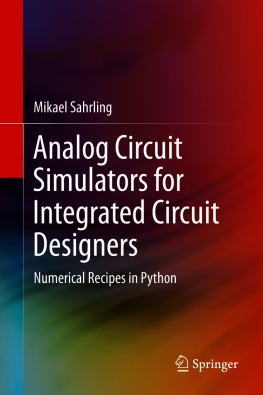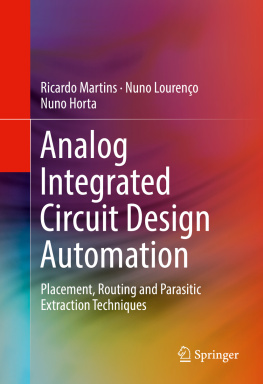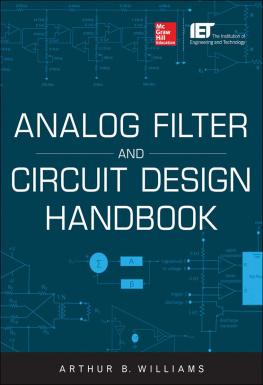Williams - Analog Circuit Design
Here you can read online Williams - Analog Circuit Design full text of the book (entire story) in english for free. Download pdf and epub, get meaning, cover and reviews about this ebook. year: 1991, publisher: Elsevier Ltd., genre: Romance novel. Description of the work, (preface) as well as reviews are available. Best literature library LitArk.com created for fans of good reading and offers a wide selection of genres:
Romance novel
Science fiction
Adventure
Detective
Science
History
Home and family
Prose
Art
Politics
Computer
Non-fiction
Religion
Business
Children
Humor
Choose a favorite category and find really read worthwhile books. Enjoy immersion in the world of imagination, feel the emotions of the characters or learn something new for yourself, make an fascinating discovery.

- Book:Analog Circuit Design
- Author:
- Publisher:Elsevier Ltd.
- Genre:
- Year:1991
- Rating:4 / 5
- Favourites:Add to favourites
- Your mark:
- 80
- 1
- 2
- 3
- 4
- 5
Analog Circuit Design: summary, description and annotation
We offer to read an annotation, description, summary or preface (depends on what the author of the book "Analog Circuit Design" wrote himself). If you haven't found the necessary information about the book — write in the comments, we will try to find it.
Analog Circuit Design — read online for free the complete book (whole text) full work
Below is the text of the book, divided by pages. System saving the place of the last page read, allows you to conveniently read the book "Analog Circuit Design" online for free, without having to search again every time where you left off. Put a bookmark, and you can go to the page where you finished reading at any time.
Font size:
Interval:
Bookmark:
Jim Williams

Butterworth Heinemann is an imprint of Elsevier
Copyright 1991 by Elsevier All rights reserved.
No part of this publication may be reproduced, stored in a retrieval system, or transmitted in any form or by any means, electronic, mechanical, photocopying, recording, or otherwise, without the prior written permission of the publisher.
by selecting Customer Support and then Obtaining Permissions.
 This book is printed on acid-free paper.
This book is printed on acid-free paper.
Library of Congress Cataloging-in-Publication Data
Analog circuit design: art, science, and personalities / edited by
Jim Williams.
p. cm. (The EDN series for design engineers)
Includes bibliographical references and index.
ISBN-13: 978-0-7506-9640-1 ISBN-10: 0-7506-9640-0
1. Linear integrated circuits-Maintenance and repair.
2. Electronic circuit design. I. Williams, Jim, 1948-.
II. Series
TK7874.A548 1991 91-9930
621.3815-dc20 CIP
British Library Cataloguing-in-Publication Data
1. Analogue circuits, Design
I. Williams, Jim 1948- II. Series
621.3815
ISBN-13: 978-0-7506-9640-1
ISBN-10: 0-7506-9640-0
The publisher offers special discounts on bulk orders of this book.
For information, please contact:
Manager of Special Sales
Elsevier
200 Wheeler Road
Burlington, MA 01803
Tel: 781-313-4700
Fax: 781-313-4802
Transferred to Digital Printing, 2010
Printed in the United States of America
Editorial, design and production services provided by HighText Publications, Inc.
Solana Beach, California.
For Celia, Michael, and Bonillas.
These are my friends, and this is what we do.
Bob Widlars contributions, albeit not received for this book, are acknowledged by all.
This is a weird book. When I was asked to write it I refused, because I didnt believe anybody could, or should, try to explain how to do analog design. Later, I decided the book might be possible, but only if it was written by many authors, each with their own style, topic, and opinions. There should be an absolute minimum of editing, no subject or style requirements, no planned page count, no outline, no nothing! I wanted the books construction to reflect its subject. What I asked for was essentially a mandate for chaos. To my utter astonishment the publisher agreed and we lurched hopefully forward.
A meeting at my home in February 1989 was well-attended by potential participants. What we concluded went something like this: everyone would go off and write about anything that could remotely be construed as relevant to analog design. Additionally, no author would tell any other author what they were writing about. The hope was that the reader would see many different styles and approaches to analog design, along with some commonalities. Hopefully, this would lend courage to someone seeking to do analog work. There are many very different ways to proceed, and every designer has to find a way that feels right.
This evolution of a style, of getting to know oneself, is critical to doing good design. The single greatest asset a designer has is self-knowledge. Knowing when your thinking feels right, and when youre trying to fool yourself. Recognizing when the design is where you want it to be, and when youre pretending it is because youre only human. Knowing your strengths and weaknesses, prowesses and prejudices. Learning to recognize when to ask questions and when to believe your answers.
Formal training can augment all this, but cannot replace it or obviate its necessity. I think that factor is responsible for some of the mystique associated with analog design. Further, I think that someone approaching the field needs to see that there are lots of ways to do this stuff. They should be made to feel comfortable experimenting and evolving their own methods.
The risk in this book, that it will come across as an exercise in discord, is also its promise. As it went together, I began to feel less nervous. People wrote about all kinds of things in all kinds of ways. They had some very different views of the world. But also detectable were commonalities many found essential. It is our hope that readers will see this somewhat discordant book as a reflection of the analog design process. Take what you like, cook it any way you want to, and leave the rest.
Things wouldnt be complete without a special thanks to Carol Lewis and Harry Helms at HighText Publications, and John Martindale at Butterworth-Heinemann Publishers. They took on a book with an amorphous charter and no rudder and made it work. A midstream change of publishers didnt bother Carol and Harry, and John didnt seem to get nervous over a pretty risky approach to book writing.
I hope this book is as interesting and fun to read as it was to put together. Have a good time.
J IM W ILLIAMS is the editor-in-chief of this book. In this role, Jim developed the basic concept of the book, identified, contacted, and cajoled potential contributors, and served as the guiding light of the entire project. Jim was at the Massachusetts Institute of Technology from 1969 to 1979, concentrating exclusively on analog circuit design. His teaching and research interests involved application of analog circuit techniques to biochemical and biomedical problems. Concurrently, he consulted U.S. and foreign concerns and governments, specializing in analog circuits. In 1979, he moved to National Semiconductor Corp., continuing work in the analog area with the Linear Integrated Circuits Group. In 1983, he joined Linear Technology Corp. as staff scientist, where he is presently employed. Interests include product definition, development, and support. Jim has authored over 250 publications relating to analog circuit design. His spare time interests include sports cars, collecting antique scientific instruments, art, and restoring and using old Tektronix oscilloscopes. He lives in Belmont, California, with his wife Celia, son Michael, a dog named Bonillas and 14 Tektronix oscilloscopes.
O HN A DDIS received his B.S.E.E. from the Massachusetts Institute of Technology in 1963 and joined Tektronix that same year. His career at Tektronix has been spent in the design of various vertical amplifiers and pulse sources. The products John has engineered include the 1A7, 10A2A, 7A11, 485 vertical preamplifier, 7A29, and the analog paths of the 11A32, 11A34, and 11A52. He holds 14 U.S. patents, and was formerly responsible for analog integrated circuit design for high-speed oscilloscopes at Tektronix. He is now a consultant on analog design. John has traveled widely, including three trips to the Soviet Union and two to South America.
B OB B LAUSCHILD received his B.S.E.E. from Columbia University in 1971 and his M.S.E.E. from the University of California at Berkeley in 1973. He is also proud of his diploma from Ridgefield Memorial High School in New Jersey. Bob is currently manager of advanced analog development for Signetics, and has previously been an independent design consultant. He holds 12 patents in the area of analog circuit design, served ten years on the program committee for the International Solid State Circuits Conference, and is the author of numerous technical papers. His hobbies include running, visiting with old friends, coaching in the Special Olympics, and daydreaming of retirement on a warm beach.
Font size:
Interval:
Bookmark:
Similar books «Analog Circuit Design»
Look at similar books to Analog Circuit Design. We have selected literature similar in name and meaning in the hope of providing readers with more options to find new, interesting, not yet read works.
Discussion, reviews of the book Analog Circuit Design and just readers' own opinions. Leave your comments, write what you think about the work, its meaning or the main characters. Specify what exactly you liked and what you didn't like, and why you think so.


